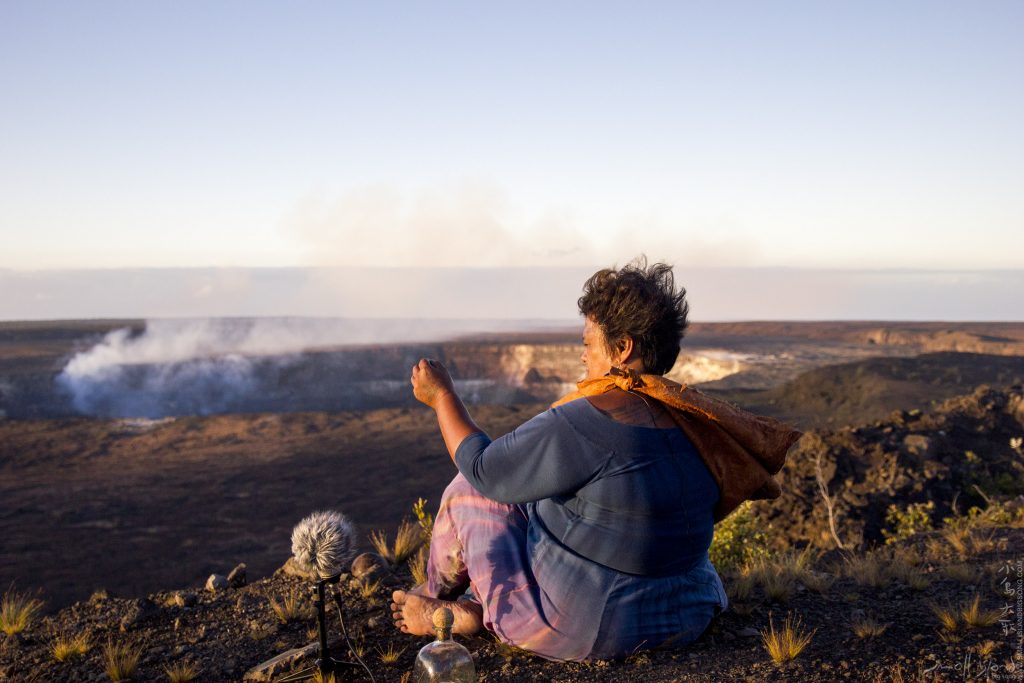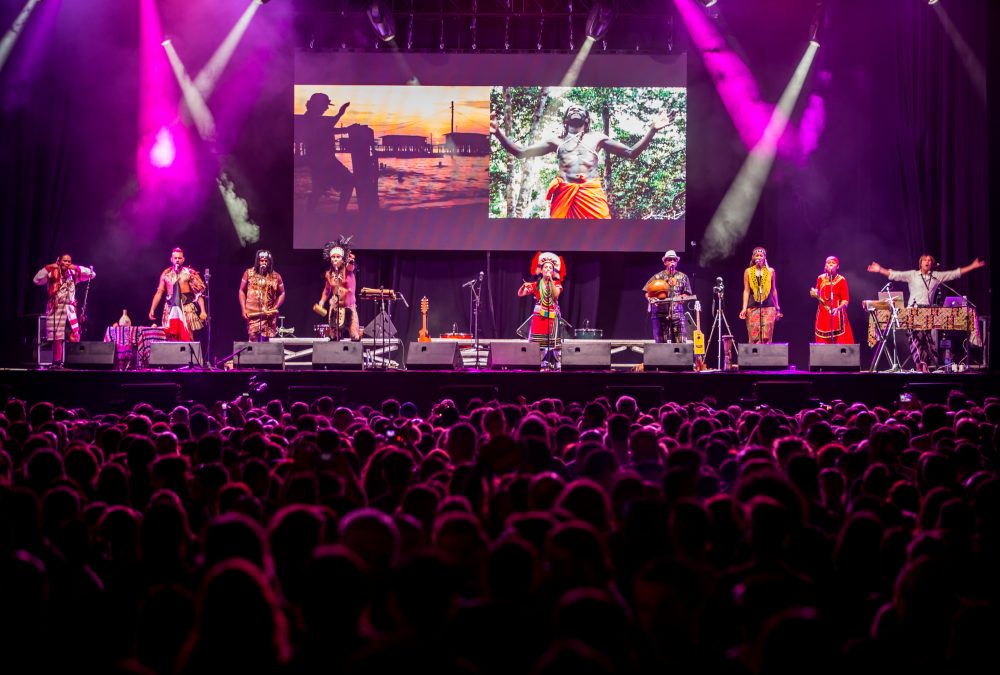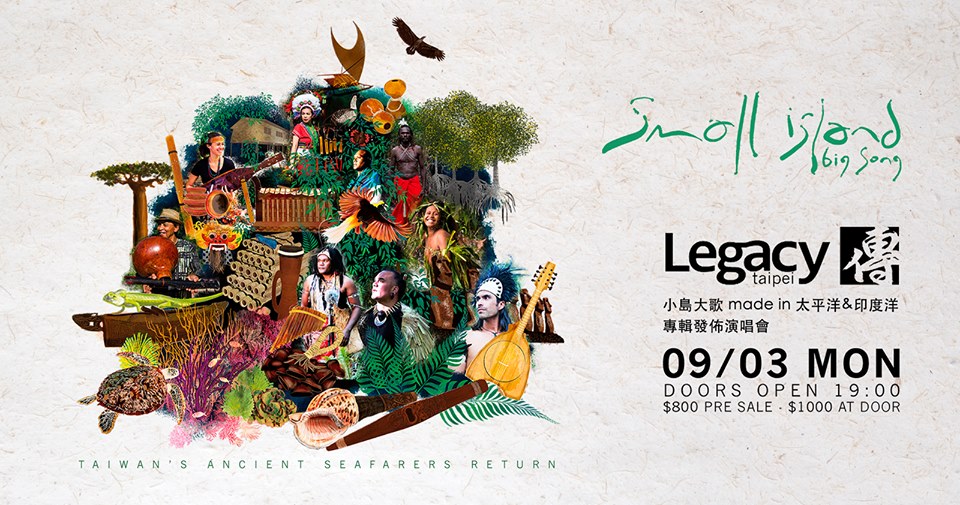Tim Cole was deep in the heart of Australia, recording desert country songlines with Aboriginal songwomen; there he heard a radio report about climate change and its impact the southern hemispheres great oceans. It struck him, hard.
“I realized that with the land we were going to loose the saltwater songlines, groups of songs that can store and pass down practical knowledge, like how to sustain communities in harmony with fragile environments.” The sort of accumulated knowledge that Cole was tracing with the Aboriginal elders over the Australian landscape, the very knowledge we could use right now.
With life and artistic partner Bao Bao Chen, the duo set out to trace the oceanic songlines from Madagascar to Hawaii; from New Zealand to Taiwan, including the Torres Strait, following the voyages of the ancient oceanic seafarers an ancestry which can be traced along the ocean currents and seasonal winds back over 5,000 years, to an island we now call Taiwan.

The Small Island Big Song production team was recording and filming near a volcanic crater in Hawaii. (Photo courtesy of Small Island Big Song)
Visiting sixteen island nations over three years the couple recorded with many of the regions most respected cultural voices in powerful natural settings resonant to their heritage, using all acoustic instruments, local languages and compositions. Sharing the songs from Island to Island, as they developed into a lush, poignant and playful soundtrack to the region and its people, Small Island Big Song.
“If you hear an A’re A’re song you can feel and see how long it has been there. The songs are documents of who we are, the only gift our ancestors gave us. Popular music, promoted by the music business, tells us stories and says, 'This is how the world is.' It is not. It does not connect us. It does not conserve our place,” explains Small Island Big Song artist Charles Maimarosia, an Are’Are songman from the Solomon Islands.
“Through this project, we hope to create a platform for these voices to be heard,” BaoBao says. “They can share what’s going on for them in a grassroots practical way. And by experiencing music and culture, we can help people come together.”

Solomon Islands artist Charles Maimarosia. (Photo courtesy of Small Island Big Song)
Small Island Big Song launched the album in Europe & USA this July, followed by a festival tour around Europe. With Mau Power and 7 other musicians from the Pacific and Indian Oceans, they’re heading to Taiwan for an album launch tour next week. Australian album launch this Oct.
As Cole and Chen traced the songlines, they found plenty of music, yet they wanted to craft a sound that would feel fresh and contemporary though completely based in indigenous instruments. To do this, “I set rules,” Cole notes. “We used only traditional instruments and languages, and we recorded in the open where the artists chose. We did not tell people what to play. We told them what we were doing and asked them to share something they were proud of. Some things were really traditional and some were more contemporary, there’s a hip-hop and a Jawaiian reggae song.”
These perspectives, given to the project by extraordinary artists with a clear sense of the music’s power, make the project powerful, honouring the urgency of its cultural and environmental aspects “The knowledge and values in the songs are in more than the words. They are in the tempo and the melody. They are in the vibration,” explains Small Island artist, Alena Murang, who hails from the Kelabit community of Borneo.
“Music is my life. It fills my heart. Music is a gift and we cannot live without it,” states Yoyo Tuki, born on Rapa Nui (Easter Island). “It is a strong way to preserve and explain. It connects us to our ancient values, to history, to the knowledge of where we came from. It connects us to nature. In our globalised, computerised world, music can bring us awareness of who we are, our history and our values and our connection to nature. I bring what my grandfather poured into me.”

Rapa Nui artist Yoyo Tuki. (Photo courtesy of Small Island Big Song)
The traditional sounds were mixed to maintain their authenticity whilst filling the speakers, an Ipu from Hawai’i as powerful as an 808 Kick, a Solomon Islands Awaa flute solo as cranking as Jimi Hendrix at 11, as Cole worked to shape the tracks. He might add a sample from a differently placed mic, like the boom of a submerged hydrophone on “Rim Rim Siag” the track from The Vanuatu Water percussion, or combine remarkably compatible sounds and performances from far flung islands.
The whole process flowed organically from the artists themselves, layering the songs in unexpected ways. On ‘Naka Wara Wara To’o,’ we needed a replacement for the acoustic guitar,” Chen recounts. “It wasn’t an Austronesian instrument so it had to go, whilst recoding with Ben Hakalitz from Bougainville Papua New Guinea, he said so you’re looking for an instrument that’s both polyphonic and rhythmic like a guitar, I think I have just the thing at my village in Buka. Like so many of the instruments we found, you won’t believe what you’re hearing, (so lucky we filmed it all) six musicians playing tuned bamboo racks like one string each, all cut/tuned on the spot for the song. The Yumi Yet Bamboo Band of Buka also provided a unique dub bass sound, as two musicians played off each other for another song.”
Another song ‘Gasikara’, was started by Airileke at his village Gabagaba in Papua New Guinea, playing traditional drums and rhythms, but from his computer. For Airileke these contemporary music tools are still continuing his villages musical heritage, with a vision of the future. Mau Power from Zenadh Kes (The Torres Strait) contributed a rap from ‘Sing Strong’ in the Kalay Lagaw Ya language of the Guda Maluilgal nations, which was supported by another rap from Sandro of the Vezo people, the sea nomads, in Madagcascar and a powerful chorus line sung by Siao-Chun Tai of the Paiwan tribe from Taiwan. With driving bass grooves played on bamboo tubes by Ben Hakalitz recorded in Bougainville and an edgy gourd instrument called the Jejy played by Sammy Samoela in Madagascar, the song is a unique grass roots indigenous hip hop anthem, paying tribute to the cultural voice of the island people and the protection of the environment, the Torres Strait and the west coast of Madagascar are home to two of the worlds most extensive but threatened coral reefs.

Amis artist Ado' Kaliting Pacidal. (Photo courtesy of Small Island Big Song)
The lives and livelihoods of the artists on Small Island Big Song are further honoured by the structure of the projects’ contracts and payment schemes. Inspired by the sharing culture of the indigenous communities, “We’ve used a Fair Trade Music model, with 50% of the profit goes back to the contributing artists,” says Chen. Furthermore, to acknowledge the “Intangible Cultural Heritage” forming the basis for the project, selected cultural organisations will receive a share of net profits from the project, in recognition of UNESCO's Declaration on the Rights of Indigenous Peoples.
The new sonic journeys between islands has given some of the project’s participants a new way of seeing their own work and heritage, one that is both open to novel ideas and deeply respectful of past achievements. “It has been lovely to connect with other islander musicians. First of all I love their music, but more than this, working with them has given me a deeper feeling for my own culture and music. When I played in modern bands I used to feel that my tunings and tempo were a problem. I thought I was off tempo with them. I know now that my tempo and my tunings are different,” reflects Murang. “That difference comes from the music of a culture that values hard work. Whether male or female, the Kelabit value, expect and respect hard work. The difference in tempo and tuning comes from a culture that is loving and kind. It comes from a culture that welcomes the stranger.”
Small Island Big Song
Date: 03 / 09 / 2018
Venue: Legacy Taipei
Ticket: NTD 800 (Pre-Sale) / NTD 1000 (At Door) / NTD 1600 (Couple+CD)https://www.indievox.com/smallislandbigsong/event-post/20990



























